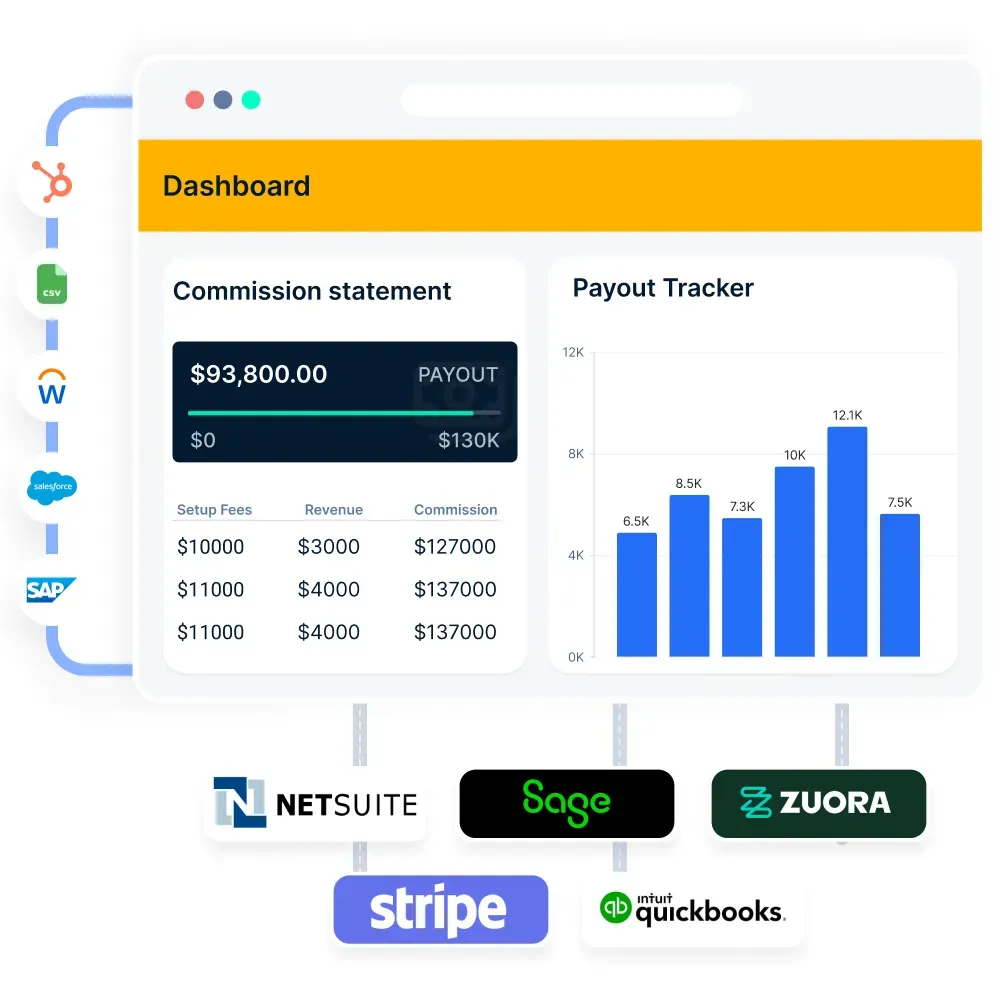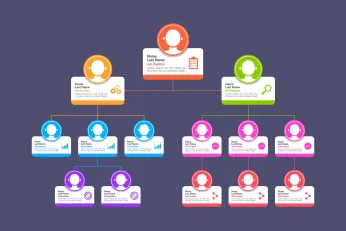11 Planes de retribución incitativa con ejemplos para 2025
Descubra cómo las mejores empresas mejoran la motivación y el rendimiento de sus empleados y conozca las razones del éxito de los programas de incentivos.
En esta página
Un plan eficaz de compensación de incentivos es una de las herramientas más poderosas para impulsar la motivación de los empleados, mejorar el rendimiento y alinear los esfuerzos individuales con los objetivos empresariales. Las empresas que aplican un plan de compensación bien estructurado no sólo aumentan las ventas, sino también la satisfacción y la retención de los empleados. Sin embargo, para diseñar el plan adecuado hay que considerar cuidadosamente varias estructuras de incentivos que respondan a objetivos tanto a corto como a largo plazo.
Este blog explora 11 de los mejores ejemplos de planes de compensación de incentivos para 2025, abarcando diversas estrategias como participación en beneficios, comisiones, primas de retención e incentivos no monetarios. Estos ejemplos le ayudarán a diseñar un plan que maximice la productividad y el compromiso, ya sea para incentivar a su equipo de ventas, recompensar a los empleados de alto rendimiento o crear una cultura de responsabilidad.
¿Qué es la indemnización de incentivo?
La remuneración incitativa es una forma de pago que se da a los empleados en función de su rendimiento o sus logros. Está diseñada para motivar a los empleados a cumplir objetivos específicos o superar las expectativas, a menudo en forma de primas, comisiones u otras recompensas económicas. Esta parte puede incluirse en
- La remuneración total de los asalariados.
- O una cantidad extra que se gana cuando los empleados alcanzan objetivos de rendimiento específicos.
¿Cómo funciona? Entre los beneficios de la compensación de incentivos se incluyen:
- Mayor motivación de los empleados,
- Rendimiento mejorado,
- Mayor productividad.
En general, la competición de incentivos para vendedores alinea las metas individuales con los objetivos de la organización, anima a los empleados a alcanzar objetivos específicos y fomenta una cultura de responsabilidad.
Al aprovechar la plataforma intuitiva de Compass, la empresa agilizó sus procesos de compensación. Compass permitió a su equipo de ventas comprender fácilmente sus ingresos y métricas de rendimiento. Como resultado, la empresa experimentó un aumento significativo en la satisfacción del equipo de ventas, con un 95% del equipo de ventas informando de queCompassles ayudó a comprender mejor su retribución.
Antes de pasar a discutir los ejemplos de planes de incentivos, vamos a compartir la diferencia entre incentivos a largo plazo y a corto plazo.
¿Qué son los incentivos a largo plazo frente a los incentivos a corto plazo?
La remuneración incitativa suele dividirse en dos tipos principales: incentivos a largo plazo e incentivos a corto plazo.
El programa de equidad pretende atraer, mantener e inspirar a los empleados, al tiempo que los pone en consonancia con los objetivos a largo plazo de la empresa.
La empresa también trata de ofrecer otras vías de desarrollo patrimonial, como el Programa Especial de Inversión para Empleados, que proporciona a los empleados que reúnen los requisitos necesarios acceso a los activos de Goldman Sachs.
8 Plan eficaz de retribución incitativa con ejemplos
La compensación de incentivos ayuda a atraer y retener a los mejores talentos, al tiempo que mejora la satisfacción y la lealtad general en el trabajo. Los siguientes son ejemplos de compensación de incentivos que puede incluir.
1. Reparto de ganancias
El reparto de beneficios es un programa que recompensa a los empleados por mejorar su productividad. Las empresas utilizan incentivos financieros para animar a los empleados a alcanzar objetivos empresariales específicos. Estos objetivos pueden incluir:
- Mayores ventas.
- Mejor servicio al cliente.
- Reducción de la rotación de personal.
- Tiempos de producción más rápidos.
Los planes de reparto de beneficios son rentables porque las primas se conceden sólo a quienes muestran mejoras cuantificables. Normalmente, estas bonificaciones se pagan mensualmente, lo que permite a los directivos hacer un seguimiento de los progresos y ajustar el programa en función de las necesidades.
Ventas mensuales de referencia: 50.000 $
Tras los esfuerzos del equipo: Las ventas aumentan a 55.000 $
Ingresos adicionales: 5.000 $
Reparto de las ganancias (20% para los empleados):
La empresa se queda con 4.000 $
Los empleados comparten: 1.000 $
Si hay 10 empleados, ¡cada uno recibe una bonificación de 100 $ como recompensa por mejorar las ventas!
2. Participación en los beneficios
La participación en los beneficios, otro ejemplo de programa de incentivos al rendimiento, consiste en compartir una parte de los beneficios de la empresa con los empleados a través de bonificaciones. A diferencia del reparto de beneficios, este plan se centra en los resultados globales de la empresa. Las primas por participación en los beneficios suelen distribuirse una vez al año. Cuanto más rentable sea la empresa, mayores serán las primas.
3. Prima de retención
Una prima de retención es un pago único que se ofrece a los empleados clave que pueden estar planteándose dejar la empresa. Este incentivo les anima a quedarse durante momentos críticos, como fusiones u otros cambios significativos. El importe puede oscilar entre el 10% y el 25% del salario del empleado, según el acuerdo.
El empleado firma un contrato de permanencia de 2 años.
La empresa le ofrece una prima de retención de 10.000 dólares si cumple los 2 años.
Si el empleado se marcha antes, no recibe la prima.
Esto motiva a los empleados a quedarse más tiempo y reduce la rotación.
4. Premios puntuales
Los premios puntuales, o primas puntuales, son recompensas inmediatas que se conceden por un rendimiento excepcional en tareas específicas. Estos premios reconocen logros que pueden no encajar en los criterios de evaluación estándar. Su valor puede oscilar entre 50 y 5.000 dólares, lo que suele representar entre el 0,25% y el 1% del total de la nómina.
Una cena en un buen restaurante.
Un trofeo por un rendimiento excepcional.
Tarjetas regalo.
Bonificaciones en metálico.
Una escapada de fin de semana a un complejo turístico.
Es un buen ejemplo de programa de incentivos al rendimiento.
5. Bonificación anual
Las primas anuales, un ejemplo de programa de incentivos al rendimiento, son pagos a tanto alzado que se hacen a los empleados además de sus salarios regulares. Estas primas pueden ser en efectivo o en opciones sobre acciones y suelen calcularse al final del año fiscal. La cuantía puede depender del rendimiento global de la empresa, del rendimiento individual o de ambos.
Una tienda minorista ofrece una bonificación de 1.000 dólares a cada representante de ventas tras un año de éxito.
Una empresa tecnológica ofrece bonificaciones anuales que oscilan entre el 5% y el 11% en función del rendimiento individual.
Una empresa manufacturera ofrece a su equipo de producción una bonificación anual fija equivalente al 10% de sus salarios base.
6. Comisiones
Las comisiones forman parte de la estructura salarial de un empleado y están diseñadas para recompensar el rendimiento. Los empleados ganan comisiones en función de sus ventas u objetivos alcanzados. Las comisiones pueden tener un tope o no.
Usted gana una comisión del 5% sobre sus ingresos por ventas.
Recibe una comisión de 2 $ por cada producto vendido.
Gana 1 $ por cada venta hasta 50 unidades y, a partir de ahí, 1,50 $ por cada venta.
El uso de un software de compensación de incentivos puede ayudar a automatizar estos cálculos para su equipo.

Automatice las comisiones con Compass
Compass ofrece una solución integral para la gestión de comisiones de ventas, que permite a las organizaciones racionalizar eficazmente sus procesos de compensación de incentivos.
Concierte una llamada ahora
7. Fondo de Incentivos al Rendimiento de las Ventas (FIPV)
Un Fondo de Incentivos para el Rendimiento de las Ventas (SPIF) es un programa de recompensas a corto plazo destinado a alcanzar rápidamente objetivos de ventas específicos. Aunque los SPIF se centran principalmente en los equipos de ventas, también pueden aplicarse en otros departamentos.
8. Bonificación MBO
Una prima de Dirección por Objetivos (DPO) vincula las recompensas de los empleados a objetivos específicos fijados en sus planes de DPO. Los directivos y los empleados trabajan juntos para establecer estos objetivos.
9. 9. Comisión de ventas
Las comisiones de ventas, un pilar de la compensación de incentivos, son especialmente relevantes para los puestos que implican directamente la generación de ingresos. Los incentivos financieros conocidos como comisiones de ventas se determinan principalmente en función del porcentaje de ingresos por ventas de un empleado.
10. Participación en los beneficios
Los empleados reciben un porcentaje de los beneficios de la empresa a través de la participación en los beneficios, que se decide en función de criterios predefinidos como la rentabilidad total o las contribuciones individuales. Esto hace que los empleados se sientan más implicados en el éxito de la empresa en su conjunto.
11. Incentivos no monetarios
Los principales objetivos de los incentivos no monetarios son fomentar un ambiente de trabajo positivo, oportunidades de desarrollo personal y reconocimiento. Según un estudio deLinkedInLearning, el 94% de los trabajadores afirman que permanecerían más tiempo en una empresa si ésta apoyara su crecimiento profesional. Considérelo:
- Programas de reconocimiento:Fomentan los comportamientos deseados reconociendo los logros de los empleados con premios, elogios o reconocimiento público.
- Oportunidades de desarrollo profesional:inversión en posibilidades de crecimiento y promoción laboral, como formación, tutoría o ascenso profesional.
¿Cómo diseñar un plan de incentivos eficaz?
Para crear un plan eficaz de retribución incitativa, necesita un planteamiento claro y organizado. Esto es aplicable a cualquier departamento. He aquí algunos pasos clave que le ayudarán a elaborar este plan:
Etapa 1: Planificación y diseño
¿Cuáles son sus objetivos? ¿Quiere aumentar los ingresos, mejorar la fidelización de clientes o dar a conocer su marca?
Empiece por definir lo que quiere conseguir y cómo se alinea con los objetivos generales de la empresa.
A continuación, elija el tipo de plan de compensación de incentivos que mejor respalde estos objetivos.
Por último, esboce un marco detallado para su plan.
Paso 2: Compromiso de las principales partes interesadas
Con el marco listo, es hora de compartirlo con las principales partes interesadas para que hagan sus aportaciones.
Este grupo suele incluir a la alta dirección, los altos directivos, los jefes de equipo y algunos miembros del equipo directivo.
Después de discutir y revisar juntos el plan, obtén su aprobación pidiéndoles que lo firmen.
Etapa 3: Comunicación y aplicación
Ahora es el momento de comunicar el plan a toda la empresa.
La comunicación eficaz es crucial en esta fase. Sería una pena tener un gran plan pero no asegurarse de que los empleados lo entienden perfectamente.
Utilice mensajes claros y sencillos, y comparta información con regularidad para asegurarse de que la aplicación se desarrolla sin problemas.
Paso 4: Revisión y optimización
Este paso es continuo. Debe revisar periódicamente el plan examinando los resultados individuales y de equipo.
¿El plan está dando los resultados esperados? ¿O han cambiado las cosas?
Es normal que los planes necesiten ajustes con el tiempo. La clave está en detectar pronto cualquier problema y hacer los cambios necesarios a medida que se avanza.
Buenas prácticas para la aplicación de un plan de retribución incitativa
A continuación se indican las mejores prácticas que debe tener en cuenta para aplicar la compensación de incentivos.
- Comunique con claridad:Para fomentar la comprensión y el apoyo, comunique claramente a los empleados los detalles del programa, los requisitos de elegibilidad y las normas de rendimiento.
- Equilibre los incentivos a corto y largo plazo:Parafomentar el éxito constante, combina beneficios a corto plazo con otros a largo plazo, como opciones sobre acciones o crecimiento profesional.
- Evaluación y modificación frecuentes:Vigile el éxito del programa, solicite opiniones y haga las modificaciones necesarias para maximizar su impacto y relevancia.
- Integración con la gestión del rendimiento:Para alinear los objetivos individuales con metas organizativas más generales, integre la compensación de incentivos con los sistemas de gestión del rendimiento.
- Concienciación legal y de cumplimiento:Manténgase al día de los últimos requisitos legales y reglamentarios para asegurarse de que su programa cumple las normas sobre empleo, impuestos y normas del sector.
Automatice las comisiones con Compass

A continuación le mostramos cómo Compass puede ayudarle a gestionar las comisiones de ventas:
Diseño sin código: Compass permite a los usuarios crear y lanzar complejos planes de comisiones de ventas rápidamente, utilizando un diseñador de planes de comisiones sin código que puede crear planes 10 veces más rápido que los métodos tradicionales.
Flexibilidad en las estructuras: Los usuarios pueden implantar diversas estructuras de incentivos, como recargos, aceleradores, bonificaciones, multiplicadores, rampas y recuperaciones, adaptadas a las distintas funciones de ventas.
Cálculos automatizados: La plataforma automatiza el cálculo de comisiones, reduciendo significativamente los errores manuales y liberando a los equipos financieros de cálculos tediosos. Esto garantiza pagos precisos en piloto automático.
Integración de datos en tiempo real: Compass se integra perfectamente con los sistemas CRM para obtener automáticamente datos de ventas, garantizando que todos los cálculos de comisiones se basen en información actualizada.
Recogida de firmas: Antes de poner en marcha nuevos planes de comisiones, Compass facilita la recogida de firmas de los representantes de ventas para garantizar la aceptación y la transparencia.
Registros de auditoría: El sistema mantiene un registro de auditoría que rastrea los ajustes y anulaciones realizados en cualquier plan de comisiones, lo que mejora la rendición de cuentas y el cumplimiento de las directrices financieras.
Visibilidad para los equipos de ventas: Los representantes de ventas pueden ver sus cálculos de comisiones por adelantado y supervisar las métricas clave de rendimiento. Esta transparencia ayuda a alinear sus esfuerzos con los objetivos de la organización.
Colaboración entre equipos: Compass fomenta la colaboración entre los líderes de ventas, las operaciones y los equipos financieros al proporcionar visibilidad de los procesos de comisiones y resolver las disputas de forma eficiente.
Conclusión
Los ejemplos de compensación de incentivos de este blog muestran cómo las recompensas pueden alinearse estratégicamente con los objetivos de la organización para mejorar el compromiso y el rendimiento de los empleados. Las organizaciones pueden fomentar una plantilla motivada y preparada para el éxito a largo plazo y obtener una ventaja en el mercado poniendo en marcha programas de incentivos equilibrados y transparentes.
Mediante la implantación de programas de incentivos equilibrados y transparentes, las organizaciones pueden fomentar una plantilla motivada y preparada para el éxito a largo plazo y obtener una ventaja competitiva en el mercado. Descubra cómoCompasspuede ayudar a su organización a diseñar programas eficaces de compensación de incentivos que impulsen el éxito.Concierte una llamadaahora
Preguntas frecuentes
¿Cuáles son las estrategias de un plan de retribución incitativa?
Las estrategias para un plan eficaz de compensación de incentivos incluyen:
- Alinear los incentivos con los objetivos de la empresa
- Utilizar recompensas monetarias y no monetarias
- Incentivos a corto y largo plazo
- Revisar y optimizar periódicamente el plan en función de los datos sobre resultados
- Garantizar una comunicación clara de los objetivos y expectativas a los empleados.
¿La remuneración incitativa es buena o mala?
La remuneración incitativa puede ser beneficiosa, ya que motiva a los empleados a alcanzar objetivos específicos, pero su eficacia depende de lo bien que se ajuste a las motivaciones de los empleados y a los objetivos de la organización.
¿La remuneración incitativa es una prima?
Sí, la remuneración incitativa puede incluir primas y pagos adicionales efectuados para cumplir métricas de rendimiento más allá de las obligaciones laborales habituales.
¿Qué es un ejemplo de incentivo?
Un ejemplo de incentivo es una prima basada en el rendimiento, que recompensa a los empleados por alcanzar metas u objetivos específicos relacionados con sus funciones.
¿Cuál es la forma más básica de remuneración incitativa?
La forma más básica de remuneración incitativa son los planes de comisiones de ventas, que proporcionan una cantidad fija basada en el rendimiento individual de las ventas.












